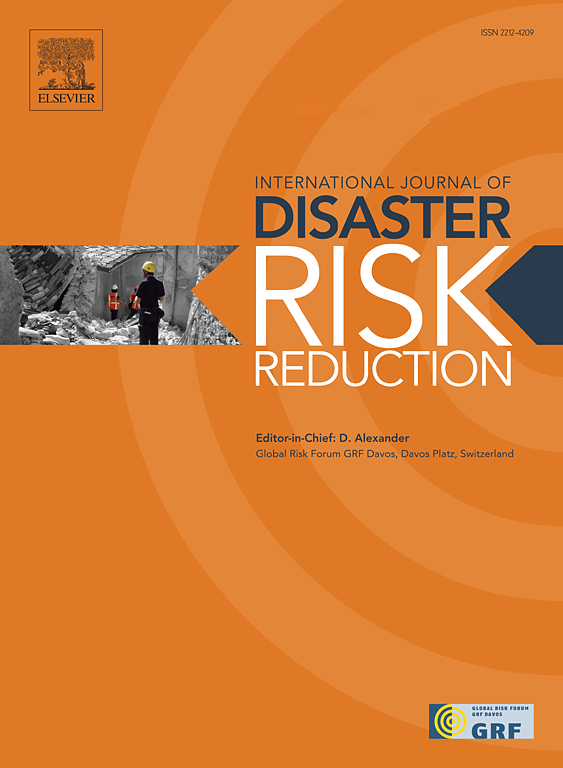揭示脆弱性:在住宅暴露建模中整合社会经济和物理维度
IF 4.2
1区 地球科学
Q1 GEOSCIENCES, MULTIDISCIPLINARY
International journal of disaster risk reduction
Pub Date : 2025-05-06
DOI:10.1016/j.ijdrr.2025.105557
引用次数: 0
摘要
自然灾害暴露建模涉及编制一个综合数据库,其中包含特定兴趣区域内的风险要素,如人员、建筑物和基础设施。特别是住宅建筑(实体)暴露是灾害风险建模和管理的关键组成部分。然而,不能脱离其居民的社会经济特征来审查它,特别是在估计先进的、以人为中心的灾害影响指标(例如,人口流离失所)或分解传统指标(例如,经济损失)时,以说明灾害对不同社会阶层的不平等影响。家庭收入与其他社会经济变量一起,在影响房主或租房者就其住房的结构脆弱性做出决定方面发挥着关键作用。关键决策——例如房屋维护、建筑材料的选择和质量、遵守建筑设计规范以及采用私人保险——深受收入水平的影响。这些因素,虽然在传统的建筑暴露评估中经常被忽视,但可以显著影响风险评估和恢复计划。本研究的主要目的是在加勒比海东部的圣卢西亚建立一个住宅建筑暴露模型,该模型将物理(即建筑类型)和社会经济层面(即家庭收入水平)结合起来。该模型旨在验证一个假设,即收入较低的家庭更有可能居住在物理上脆弱的房屋中。为此,本研究引入了住宅建筑对飓风灾害的暴露模型SimLucia。SimLucia采用空间微观模拟方法,将2010年全国人口和家庭普查的地理汇总数据与2016年生活条件和家庭预算调查的空间微观数据相结合。结果是一个虚拟的家庭人口数据集,其中包含了地区一级的结构和经济属性。SimLucia模型的结果显示,低收入家庭居住在物理上更脆弱的建筑类型的可能性是其两倍以上,从而证实了最初的假设。SimLucia模型可以作为一种决策支持工具,实现有针对性的、以人为本的、有利于穷人的政策干预(例如,住房恢复融资、创收工具)。本文章由计算机程序翻译,如有差异,请以英文原文为准。
Unveiling vulnerabilities: Integrating socioeconomic and physical dimensions in residential exposure modelling
Natural hazard exposure modelling involves compiling a comprehensive database of elements at risk, such as people, buildings, and infrastructure, within a specified area of interest. Residential building (physical) exposure, in particular, is a critical component of disaster risk modelling and management. However, it cannot be examined in isolation from the socioeconomic characteristics of its residents, especially when estimating advanced, people-centred disaster impact metrics (e.g., population displacement) or disaggregating traditional metrics (e.g., financial losses) to account for the unequal impact of hazards on various societal segments. Household income, alongside other socioeconomic variables, plays a pivotal role in shaping decisions made by homeowners or renters regarding the structural vulnerability of their dwellings. Key decisions - such as home maintenance, the selection and quality of construction materials, compliance with building design codes, and the adoption of private insurance - are profoundly influenced by income levels. These factors, although frequently overlooked in conventional building exposure assessments, can significantly impact risk estimates and recovery planning. The main objective of this study is to develop a residential building exposure model that integrates both physical (i.e., building types) and socioeconomic dimensions (i.e., household income levels) in Saint Lucia, in the eastern Caribbean Sea. The model aims to test the hypothesis that income-poor households are disproportionately likely to inhabit physically vulnerable dwellings. To this end, the study introduces SimLucia, a residential building exposure model to hurricane hazards. Employing spatial microsimulation methodologies, SimLucia combines geographically aggregated data from the 2010 National Population and Household census with a-spatial microdata from the 2016 Living Conditions and Household Budgets Survey. The result is a virtual household population dataset that incorporates both structural and economic attributes at the district level. Outcomes from the SimLucia model reveal that low-income households are over twice as likely to reside in more physically vulnerable building typologies, thereby confirming the initial hypothesis. The SimLucia model can serve as a decision-support tool, enabling targeted, human-focused, and pro-poor policy interventions (e.g., housing recovery financing, income-generating instruments).
求助全文
通过发布文献求助,成功后即可免费获取论文全文。
去求助
来源期刊

International journal of disaster risk reduction
GEOSCIENCES, MULTIDISCIPLINARYMETEOROLOGY-METEOROLOGY & ATMOSPHERIC SCIENCES
CiteScore
8.70
自引率
18.00%
发文量
688
审稿时长
79 days
期刊介绍:
The International Journal of Disaster Risk Reduction (IJDRR) is the journal for researchers, policymakers and practitioners across diverse disciplines: earth sciences and their implications; environmental sciences; engineering; urban studies; geography; and the social sciences. IJDRR publishes fundamental and applied research, critical reviews, policy papers and case studies with a particular focus on multi-disciplinary research that aims to reduce the impact of natural, technological, social and intentional disasters. IJDRR stimulates exchange of ideas and knowledge transfer on disaster research, mitigation, adaptation, prevention and risk reduction at all geographical scales: local, national and international.
Key topics:-
-multifaceted disaster and cascading disasters
-the development of disaster risk reduction strategies and techniques
-discussion and development of effective warning and educational systems for risk management at all levels
-disasters associated with climate change
-vulnerability analysis and vulnerability trends
-emerging risks
-resilience against disasters.
The journal particularly encourages papers that approach risk from a multi-disciplinary perspective.
 求助内容:
求助内容: 应助结果提醒方式:
应助结果提醒方式:


